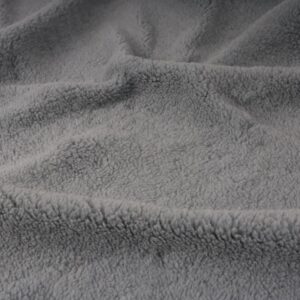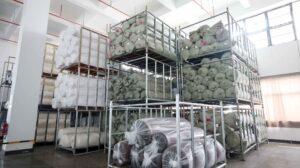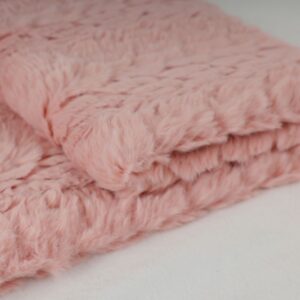Flannel fleece fabric is a soft and warm fabric. It is very common in daily life and is often used in clothing, home textiles, soft furnishings and other fields. It is light and comfortable overall and is deeply loved by consumers.
What is flannel fleece fabric?
Flannel fleece fabric is a textile fabric that undergoes a special raising and carding process, resulting in soft, delicate, and warm fabric. It combines the tight weave of flannel with the fluffy feel of fleece, resulting in a dense, smooth surface pile while also providing excellent thermal insulation.
This fabric is commonly found in winter clothing, home textiles, and thermal accessories. Its warm feel and next-to-skin comfort make it ideal for cold weather.
Introduction to Flannel Fleece Fabric Materials
Flannel fleece fabrics come in a variety of materials, including the following:
Polyester: Lightweight and soft, abrasion-resistant and pilling-resistant, it offers long-lasting wear and is suitable for mass production.
Cotton: Breathable and comfortable, with a certain degree of softness. While lightweight, it can shrink easily.
Blended fabrics: Polyester blended with other fibers such as cotton and viscose are soft, durable, and provide warmth.
What are the characteristics of flannel fleece fabric?
Soft feel: The fine pile is smooth to the touch and doesn’t irritate the skin.
High warmth: The dense pile creates a still air layer that locks in heat.
High durability: Polyester flannel, in particular, offers excellent abrasion resistance.
Saturated color: Dyes well, resulting in long-lasting colors that don’t fade easily.
Wrinkle resistance: Less noticeable creases from everyday wear.
Products suitable for flannel fleece fabric
Winter pajamas and bathrobes
Warm blankets and comforters
Infant and toddler clothing and swaddles
Sofa blankets and pillowcases
Winter coat linings
Pet beds and pet clothing
Main applications of flannel fleece fabric
Apparel: Warm homewear, nightgowns, jacket linings.
Home textiles: Blankets, sheets, sofa covers.
Infant and child products: Baby blankets and comforters.
Outdoor leisure: Camping blankets and warming pads.
Custom gifts: Customized blankets and promotional items.
Flannel Fleece Fabric Highlights
Flannel fleece fabric combines the soft texture of flannel with the warmth of fleece, resulting in several outstanding features:
- Excellent Warmth
The fleece layer has excellent loft and thermal insulation properties, effectively trapping body heat.
Providing comfortable warmth even in cold conditions.
- Soft and Comfortable Handfeel
Flannel has a fine surface and dense pile, making it soft and comfortable to the touch.
It is non-irritating when worn or in contact with the skin, making it ideal for base layer clothing.
- Lightweight and Easy to Wear
Compared to pure wool or thick outerwear, flannel fleece is lightweight and compact, making it easy to carry and layer.
- Excellent Breathability and Moisture Absorption
Flannel fleece fabric allows for adequate air circulation, reducing the feeling of stuffiness.
It is suitable for both athletic wear and casual everyday wear, and is less susceptible to sweat and discomfort.
- Durability and Easy Cleaning
The fabric structure is stable and resists pilling, shedding, or deformation. Machine or hand washable, daily care is simple.
- Diverse Styles and Colors
Flannel fleece is easy to dye, creating a rich variety of colors and patterns.
Suitable for outerwear, homewear, children’s clothing, scarves, and more.
Advantages and Disadvantages of Flannel Fleece Fabric
Advantages:
Soft and comfortable, with excellent warmth retention.
Easy to dye with high color fastness.
Resists wrinkling and is easy to care for.
Suitable for various processing techniques, such as printing and embossing.
Disadvantages:
Some pure polyester materials have limited breathability.
May pill with prolonged friction.
Significant static electricity generation, requiring anti-static treatment.
How to Identify Flannel Fleece Fabrics?
Look at the surface: The pile should be fine and even, with no noticeable bald spots.
Touch: It should be soft and smooth, not itchy.
Smell: High-quality fabrics should not have a pungent chemical odor.
Burning Test: Cotton smells like paper when burned, while polyester smells like plastic and forms lumps.
How to Clean Flannel Fleece Fabrics?
Low-Temperature Washing: The recommended water temperature is no more than 30°C to avoid damaging the fiber structure.
Mild Detergent: Avoid using bleach or strong alkaline detergents.
Gentle Machine Wash or Hand Wash: Reduces friction and pilling.
Air Dry: Avoid direct sunlight to prevent fading and hardening.
Comparison of Flannel Fleece and Coral Fleece Fabrics
| Feature | Flannel Fleece | Coral fleece fabric |
| Fiber Density | Higher, tighter weave | Lower, more fluffy |
| Touch | Soft and smooth | Fluffy and soft |
| Warmth | Strong | Strong |
| Durability | Higher abrasion resistance | Slightly lower |
| Appearance | Flat with fine texture | Puffy with long fibers |
| Application | Clothing, bedding | Bedding, blankets |
Flannel Fleece Fabric Care and Maintenance Guide
Regular dust removal: Prevent dust accumulation in the fleece.
Anti-static treatment: Use anti-static spray or add fabric softener during washing.
Avoid scratches:Avoid scratches with sharp objects to prevent snagging.
Proper storage: When not in use for extended periods, keep the fabric in a dry and well-ventilated area to prevent mold and moth damage.
Conclusion
Flannel fleece fabric, with its soft feel, excellent warmth, and diverse applications, holds a significant position in the apparel, home textiles, and baby products sectors. Consumers should consider the material composition and processing quality based on their specific needs, and ensure proper cleaning and maintenance during daily use to extend the fabric’s lifespan and maintain its appearance and comfort.






